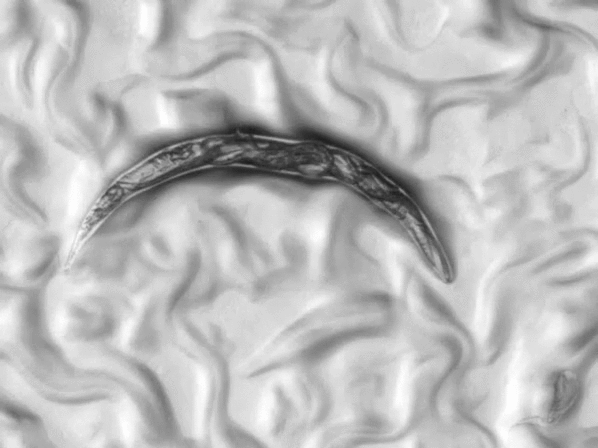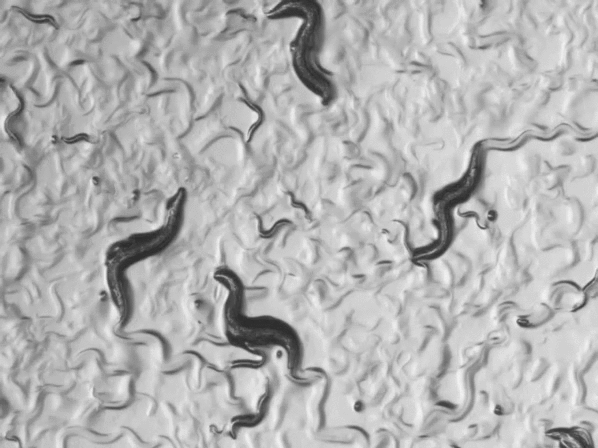Navigation auf uzh.ch
Navigation auf uzh.ch
We are investigating the different roles the conserved EGFR/RAS/MAPK signaling pathway plays during the development of two different organs in Caenorhabditis elegans. The first organ, the vulva of the hermaphrodite, is a paradigm model to study how the combined action of the evolutionary conserved EGFR/RAS/MAPK, WNT and NOTCH signaling pathways determines an invariant pattern of cell fates during organogenesis, leading to the formation of a simple organ consisting of 22 cells. In the second organ, the hermaphrodite gonad, we are investigating the differentiation of the germ cells. Germ cell proliferation and differentiation are also controlled by the NOTCH and RAS/MAPK signaling pathways, but in contrast to the vulva, the germ cells do not follow a fixed cell lineage. Approximately half of the germ cells in meiotic prophase I are eliminated through apoptosis. The decision whether a germ cell enters oogenesis or undergoes apoptosis is made in a stochastic manner. Germ cell development thus serves as a model to study cell homeostasis in a self-renewing organ.


Key publications
Maxeiner S, Grolleman J, Schmid T, Kammenga J, Hajnal A. Life Alliance. 2019 May 24;2(3). pii: e201800255. doi: 10.26508/lsa.201800255. Print 2019 Jun.
PMID: 3112699 4Free PMC Article
Walser M, Umbricht CA, Fröhli E, Nanni P, Hajnal A.
PLoS Genet. 2017 Jan 30;13(1):e1006592.
doi: 10.1371/journal.pgen.1006592. 2017 Jan.
PMID: 28135265 Free PMC Article
Systemic Regulation of RAS/MAPK Signaling by the Serotonin Metabolite 5-HIAA. Schmid T, Snoek LB, Fröhli E, van der Bent ML, Kammenga J, Hajnal A.
PLoS Genet. 2015 May 15;11(5):e1005236.
doi: 10.1371/journal.pgen.1005236. eCollection 2015 May.
PMID: 25978500 Free PMC Article
Haag A, Gutierrez P, Bühler A, Walser M, Yang Q, Langouët M, Kradolfer D, Fröhli E, Herrmann CJ, Hajnal A, Escobar-Restrepo JM.
PLoS Genet. 2014 May 1;10(5):e1004341.
doi: 10.1371/journal.pgen.1004341. eCollection 2014 May.
PMID: 24785082 Free PMC Article
PTEN negatively regulates MAPK signaling during Caenorhabditis elegans vulval development.
Nakdimon I, Walser M, Fröhli E, Hajnal A.
Genet. 2012;8(8):e1002881.
doi: 10.1371/journal.pgen.1002881.
Epub 2012 Aug 16.
PMID: 22916028 Free PMC Article
Stetak A, Hoier EF, Croce A, Cassata G, Di Fiore PP, Hajnal A.
EMBO J. 2006 Jun 7;25(11):2347-57.
Epub 2006 May 11.
PMID: 16688213 Free PMC Article
Berset TA, Hoier EF, Hajnal A.
Genes Dev. 2005 Jun 1;19(11):1328-40.
Epub 2005 May 18.
PMID: 15901674 Free PMC Article
EGF signal propagation during C. elegans vulval development mediated by ROM-1 rhomboid.
Dutt A, Canevascini S, Froehli-Hoier E, Hajnal A.
PLoS Biol. 2004 Nov;2(11):e334.
Epub 2004 Sep 28.
PMID: 15455032Free PMC Article
Battu G, Hoier EF, Hajnal A.
Development. 2003 Jun;130(12):2567-77.
PMID: 12736202 Free Article